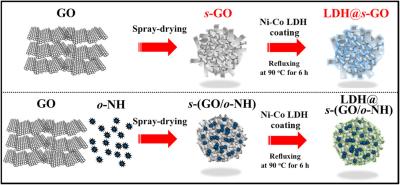Ni-Co layered double hydroxides (LDH) are seen as promising materials for pseudocapacitor electrodes. Researchers from Chonnam National University and Korea Institute of Science and Technology (KIST) recently conducted a study that focused on the use of graphene oxide (GO) and single-walled carbon nanohorns (SWCNHs) hybrid as an efficient platform for LDH coating materials for supercapacitor electrodes.
The team explained that the novel Ni-Co LDH and GO/SWCNHs composite-based supercapacitor electrode material could be a potential choice for pseudocapacitor applications thanks to its superior electrochemical properties and ease of production, which is ideal for various commercial and industrial applications.
Supercapacitors are classed as electric double-layer capacitors (EDLCs) or pseudocapacitors, depending upon their energy storage mechanism. Energy storage in an EDLC is related to a non-Faradaic mechanism involving physical absorption and dissociation of electroactive species at the surfaces of the supercapacitor electrode material and electrolytes. On the other hand, energy storage in pseudocapacitors is principally reliant on reversible Faradaic interactions between the supercapacitor electrode material's interface functional groups.
Graphene oxide (GO) possesses appealing properties for supercapacitor electrode material applications, such as numerous reactive groups and multimodal ion transport pathways. However, the graphene oxide-based supercapacitor electrode material also has significant drawbacks, such as the unloading of graphene layers during the reduction reaction, insulating properties, and poor bulk density.
SWCNHs have also been investigated as a supercapacitor electrode material due to their large specific surface area (SSA), tunable porous structure, and excellent electrical conductance. SWCNHs with conical tubular structures form robust spherical aggregates and have enclosed graphitic single-wall structures comparable to single-walled carbon nanotubes (SWCNTs).
However, contrary to SWCNTs with exceptional crystallization, SWCNHs contain various structural flaws such as pentagons and heptagons, allowing nanoscale holes to develop on the interface of SWCNHs in oxidizing environments, restricting their usability as appropriate supercapacitor electrodes.
Electrode substances such as metallic oxides, metallic hydroxides, and conductive polymers are regarded as promising contenders for pseudocapacitive energy storage technologies due to the bidirectional Faradaic processes at the electrode-electrolyte contacts.
Nickel-cobalt (Ni-Co) layered double hydroxide (LDH) with adjustable topologies is an attractive supercapacitor electrode material because of its cheap cost, nontoxicity, abundance in nature, and outstanding electrochemical stability.
Hydrothermal and electrolytic deposition techniques generally create Ni-Co nanostructures. The structural morphologies significantly impact the electrolytic capabilities of Ni-Co layered double hydroxide electrodes. Therefore, composites of Ni-Co nanostructures and carbon porous substances such as graphene oxide (GO) and SWCNHs must be investigated to increase the efficiency of Ni-Co LDH-based supercapacitor electrode material.
In their new study, the researchers developed a two-step technique for producing composite materials made of Ni-Co LDH, graphene oxide (GO), and oxidized single-walled carbon nanohorns (SWCNHs). The first stage was to spray-dry a combination of GO and SWCNHs to create spherical hybrid particles ideal for mass manufacturing due to the simple and cost-effective procedure.
In the second stage, extremely thin nickel-cobalt (Ni-Co) LDH nanosheets were hydrothermally coated on graphene oxide microspheres and single-walled carbon nanohorns to manufacture the novel supercapacitor electrode material.
The pseudocapacitive activity of hybrid supercapacitor electrode material was evaluated in specific capacity and cycling efficiency. During the study, the impacts of the activated carbon substrate composition on the morphology and electrolytic efficacy of Ni-Co LDH were also investigated.
The graphene oxide and SWCNHs-based composite had a comparatively high SSA and electric conductance, resulting in a significant effective area for interactions between the supercapacitor electrode material and electrolytic ions during the electrolysis reaction.
The new Ni-Co LDH and GO/SWCNHs composite-based supercapacitor electrode material demonstrated considerably high gravimetric specific capacity and outstanding specific capacitance stability in an aqueous electrolyte environment. These findings might be attributed to the high electrical conductance and pseudo-capacitance of the nanohybrid GO/SWCHNs and coated Ni-Co LDH.
Based on these results, the team sees the novel supercapacitor electrode material as a promising material for future energy storage applications.


